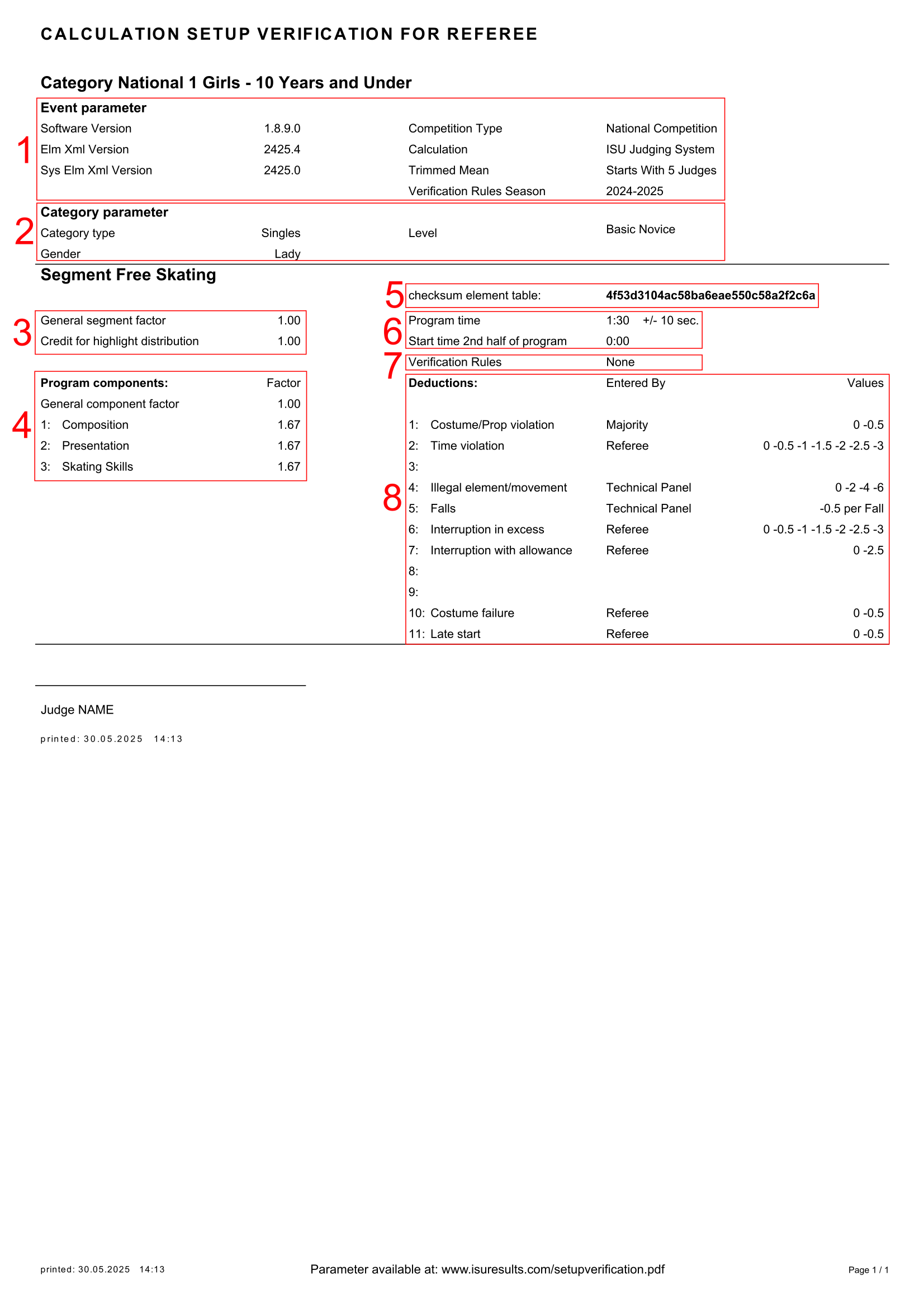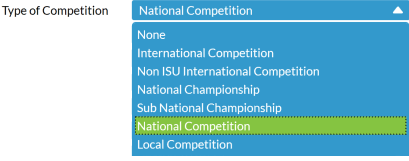Anatomy of a Calculation Setup Verification Sheet
Below (Fig. 1) is an example of a setup verification sheet, with annotations explaining some of the key features and how they are configured:

 Figure 1: ISU Calculation Setup Verification Sheet generated by FS Manager.
Figure 1: ISU Calculation Setup Verification Sheet generated by FS Manager.
1: Event parameters
These parameters configure the event overall and should remain consistent between categories:
- Software version: records the version of FS Manager used to generate the competition database. Should be the most recent version, barring extenuating circumstances e.g., updates released mid-competition.
- Elm Xml and Sys Elm Xml version: records the version of the file containing the elements and their associated Scale of Values imported into the scoring database. The current version numbers are documented at www.isuresults.com/setupverification.pdf.
- Competition Type: Defines the type of competition from the options shown in Figure 2. The International Competition option enforces the use of ISU regulations, whilst all other options allow the definition of custom scoring parameters.

 Figure 2: Dropdown list in FS Manager showing options for competition types.
Figure 2: Dropdown list in FS Manager showing options for competition types.
- Trimmed Mean: Defines the number of judges from which the trimmed mean final score is calculated. Options are None, 5, 6 or 7.
- Verification Rules Season: Defines the season of the verification rules applied to the competition.
2: Category parameters
- Category Type: Defines the category type e.g., Singles, Ice Dance etc.
- Gender: Defines the gender of the competitors, with options as Man, Lady or Mixed.
- Level: Defines the level of the competition, e.g., Senior, Junior, Advanced Novice, etc. If this option reads “Custom”, the competition can implement custom-configured verification rules. This option may also read custom if verification is disabled, but non-standard factors are implemented for the segment that have been defined in a custom setup file.
Segment parameters
3: General factors
- General segment factor: This factor is used to multiply the final score of the entire segment. This is typically 1.00, but is set to lower values for novice level pattern dances.
- Credit for highlight distribution: This factor is used to multiply qualifying element scores in the second half of the program (i.e., jumps at Junior and Senior levels). The time after which this factor is applied is defined in Section 6.
4: Component factors
This section configures the component factors of the program. Each component can have an independently defined factor, though in practice this is rarely, if ever, the case.
- General component factor: this is a flat value by which all component factors are multiplied. Should be left at 1.00 without explicit justification, given that component values can be individually configured.
5: Element checksum
The element checksum is a checksum value generated from the contents of the element file loaded into FS Manager. This value should match the value for the corresponding suite of elements published at the URL listed at the bottom of the Calculation Setup Sheet (www.isuresults.com/setupverification.pdf).
Info
It is possible to introduce custom elements into the element list of FS Manager without altering the checksum, provided that these custom elements do not modify the base elements. The procedure for doing so is discussed here.
6: Time settings
- Program time: defines the length of the program for the segment, and the margin of error allowable. The options for the margin are +/- 10 sec., max. and approx., and cannot be further configured (Fig. 3).

 Figure 3: Dropdown list in FS Manager showing options for extra time.
Figure 3: Dropdown list in FS Manager showing options for extra time. - Start time 2nd half of program: defines the middle point of the program for performances where bonus credit is given for elements performed after the halfway point. If 0:00 is shown, no bonus is awarded for elements in the second half of the program.
Note
The program time setting will only determine the time warnings shown on the results team’s screen. Any time violation deductions must be imposed manually by the referee.
7: Verification rules
This setting defines the verification rules that are used to check elements against during the performance. The options for this setting are ISU Rules, None or Custom.
- ISU rules will use the chosen season’s verification rules for the chosen level as defined by Swiss Timing. These rules are therefore only directly applicable to internationally recognised category levels.
- None will allow all elements corresponding to the current segment type as valid, but will also enable manual placement of asterisks to invalidate elements by the Data Relay Operator.
- Custom will load custom defined verification rules created by the results team.
Note
Regardless of the setting defined in this section, it is possible for the results team to override the determination of the validity generated by the results software at the instruction of the referee and technical controller.
8: Deductions
This section defines the deductions applicable to the segment and their corresponding values.